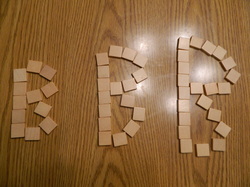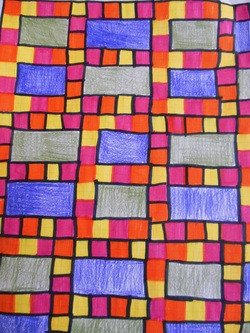A basic break down of the learning preferences assessed follows from a Silver, Strong, Perrini and Tuculescu article, The Thoughtful Classroom:Making Students as Important as Standards.
- Mastery learners want to learn practical information and procedures (what)
- Interpersonal learners want to dialogue and collaborate (how)
- Self-expressive learners want to use their imagination to explore (how)
- Understanding learners want to learn why things work (what)
I thought I'd share how this semester's group of preservice elementary teachers look, and how that affects my planning. Mostly it doesn't change what I want them to experience, but it has a reasonably big impact on how I implement it. Also, with an education class, it's a chance to point out the tension between surface and core beliefs.
Yes, I put it in GeoGebra to help visualize. (I may have a problem. Here's the sketch if you want to use it to visualize your student information.)
Here's the most consistency. Students who feel like "tell me then I practice" is how to learn. The challenge for this group is abstract or open-ended problems. Also known as all my favorite stuff in math. How I'm responding is to be explicit about what kind of problem we're working on, and support with structural suggestions. Like in working on trying to find all the pentominoes this week, I interrupted several times, solicited progress reports from groups ("They have 16?!"), and got them to share method and develop methods as a whole group.
Especially worrisome is when you compare my inventory with their composite. At the conference where I first saw this inventory I had a number of students. They divided us up by table based on the results and I was alone! So I'm aware of my distance from students on this and how it can affect my persective.
Whoa. All over the place. This is a caution to me to not require group work always, and to look for ways to make space for some individual problem solving. Since relationship with teacher is part of this, I'm trying to be more personal to supplement for the people at the top end of this scale.
Very encouraging. Many times when learners have had negative math experiences this category can be quite low. I have to think about how to support those four students, though. So much of our class revolves around this kind of why thinking. And I feel that it is crucial for future teachers. I hope to have experiences that justify this approach to math. Maybe the way conceptual understanding furthers skill is the entry point?

Another one where the students are well spread out. We started with a week long focus on creativity, that really got pretty good buy in from my perspective. Again the students who do not favor this kind of learning are a challenge for me. Choice in assessment is part of the course structure, but that's probably not enough. What more can I do for them? Is it important for all teachers to be at least comfortable with this mode?
Teacher-Student Alignment
Here's my graph compared with theirs.
This probably comes through in the Mastery section above, but it's clear where I don't align with students. In some math classes I give choices for practicing content that can satisfy Mastery learners, but there's just not much of that for this class. I'd welcome any suggestions here, is what I'm saying.
 The view of all their regions at once also raises a concern about students who seem to have low responses across the board, as I think that's just overall discomfort with mathematics.
The view of all their regions at once also raises a concern about students who seem to have low responses across the board, as I think that's just overall discomfort with mathematics.The goal with this post was to share what use I make of this information. If that didn't come through, or if you have ideas for more uses, please let me know!
Post Script: went through the survey with my 8th grader - very interesting discussion. Discussing why he was answering what he did on the individual questions was enlightening. It makes me wonder about using this as an interview tool. Even for a student I know pretty well, we got to some new ground.
Post Post Script: forgot to add the other questions' data. Even if it's mostly for fun, some illumination is to be had.
Motto
- 16 - Show me how and let me practice.
- 2 - I want to know why.
- 1 - Let me play with it. (My choice)
- 0 - Let’s talk about it and hear everyone’s ideas.
- 10 - p. 101: 1-39 odd
- 6 - Draw a picture that shows the ideas. (My choice)
- 3 - Work with a group to make a math skit.
- 0 - Report on a math controversy.


















